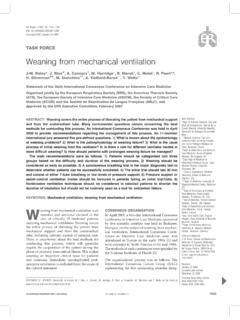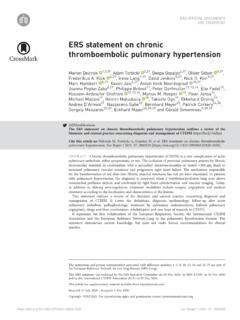Transcription of European Respiratory Society guidelines’for the management …
1 TASK FORCE REPORT. ERS GUIDELINES. European Respiratory Society guidelines for the management of adult bronchiectasis Eva Polverino1, Pieter C. Goeminne2,3, Melissa J. McDonnell4,5,6, Stefano Aliberti 7, Sara E. Marshall8, Michael R. Loebinger9, Marlene Murris10, Rafael Cant n11, Antoni Torres12, Katerina Dimakou13, Anthony De Soyza14,15, Adam T. Hill16, Charles S. Haworth17, Montserrat Vendrell18, Felix C. Ringshausen19, Dragan Subotic20, Robert Wilson9, Jordi Vilar 21, Bjorn Stallberg22, Tobias Welte19, Gernot Rohde23, Francesco Blasi7, Stuart Elborn9,24, Marta Almagro25, Alan Timothy25, Thomas Ruddy25, Thomy Tonia26, David Rigau27 and James D. Chalmers28. @ERSpublications The publication of the first ERS guidelines for bronchiectasis Cite this article as: Polverino E, Goeminne PC, McDonnell MJ, et al. European Respiratory Society guidelines for the management of adult bronchiectasis.
2 Eur Respir J 2017; 50: 1700629 [ ]. ABSTRACT Bronchiectasis in adults is a chronic disorder associated with poor quality of life and frequent exacerbations in many patients. There have been no previous international guidelines. The European Respiratory Society guidelines for the management of adult bronchiectasis describe the appropriate investigation and treatment strategies determined by a systematic review of the literature. A multidisciplinary group representing Respiratory medicine, microbiology, physiotherapy, thoracic surgery, primary care, methodology and patients considered the most relevant clinical questions (for both clinicians and patients) related to management of bronchiectasis. Nine key clinical questions were generated and a systematic review was conducted to identify published systematic reviews, randomised clinical trials and observational studies that answered these questions.
3 We used the GRADE approach to define the quality of the evidence and the level of recommendations. The resulting guideline addresses the investigation of underlying causes of bronchiectasis, treatment of exacerbations, pathogen eradication, long term antibiotic treatment, anti-inflammatories, mucoactive drugs, bronchodilators, surgical treatment and Respiratory physiotherapy. These recommendations can be used to benchmark quality of care for people with bronchiectasis across Europe and to improve outcomes. This article has supplementary material available from Received: March 26 2017 | Accepted after revision: July 10 2017. The guidelines published by the European Respiratory Society (ERS) incorporate data obtained from a comprehensive and systematic literature review of the most recent studies available at the time. Health professionals are encouraged to take the guidelines into account in their clinical practice.
4 However, the recommendations issued by this guideline may not be appropriate for use in all situations. It is the individual responsibility of health professionals to consult other sources of relevant information, to make appropriate and accurate decisions in consideration of each patient's health condition and in consultation with that patient and the patient's caregiver where appropriate and/or necessary, and to verify rules and regulations applicable to drugs and devices at the time of prescription. This document was endorsed by the ERS Executive Committee and by the European Society of Clinical Microbiology and Infectious Disease in August 2017. Copyright ERS 2017. Eur Respir J 2017; 50: 1700629. ERS GUIDELINES | E. POLVERINO ET AL. Affiliations: 1 Servei de Pneumologia, Hospital Universitari Vall d'Hebron (HUVH), Institut de Recerca Vall d'Hebron (VHIR); Fundaci n Cl nic, Hospital Cl nic de Barcelona, Universitat de Barcelona, IDIBAPS, CIBERES.
5 Barcelona, Barcelona, Spain. 2 Dept of Respiratory Medicine, AZ Nikolaas, Sint-Niklaas, Belgium. 3 Dept of Respiratory Medicine, UZ Leuven, Leuven, Belgium. 4 Dept of Respiratory Medicine, Galway University Hospitals, Galway, Ireland. 5 Lung biology Group, National University of Ireland, Galway, Ireland. 6 Institute of Cell and Molecular biology , Newcastle University, Newcastle upon Tyne, UK. 7 Dept of pathophysiology and Transplantation, Universit degli Studi di Milano, Internal Medicine Department, Respiratory Unit and Adult Cystic Fibrosis Center Fondazione IRCCS C Granda Ospedale Maggiore Policlinico Milan, Milan, Italy. 8 Dept of Clinical Research, Immunology and Physiological Sciences, Wellcome, London, UK. 9 Host Defence Unit, Royal Brompton Hospital, Imperial College, London, UK. 10 Service de Pneumologie, H pital Larrey, CHU de Toulouse, Toulouse, France.
6 11 Servicio de Microbiolog a, Hospital Universitario Ram n y Cajal and Instituto Ram n y Cajal de Investigaci n Sanitaria (IRYCIS), Madrid, Spain. 12 Servei de Pneumologia, Hospital Cl nic de Barcelona, Universitat de Barcelona, IDIBAPS, CIBERES Barcelona, Barcelona, Spain. 135th Pulmonary Dept, Sotiria Chest Hospital, Athens, Greece. 14 Institute of cellular Medicine, Newcastle University, Newcastle upon Tyne, UK. 15 Bronchiectasis Service, Freeman Hospital, Newcastle upon Tyne, UK. 16 Dept of Respiratory Medicine, Royal Infirmary and University of Edinburgh, Edinburgh, UK. 17 Cambridge Centre for Lung Infection, Papworth Hospital, Cambridge, UK. 18 Bronchiectasis Group, Girona Biomedical Research Institute (IDIBGI), Dr Trueta University Hospital, Girona, Spain. 19 Dept of Respiratory Medicine, Hannover Medical School, Member of the German Centre for Lung Research, Hannover, Germany.
7 20 Clinic for Thoracic Surgery - Clinical Centre of Serbia, University of Belgrade, Belgrade, Serbia. 21 FCS Blanquerna. Physical Activity and Health Group, Universitat Ramon Llull, Barcelona, Spain. 22 Dept of Public Health and Caring Science, Family Medicine and Preventive Medicine, Uppsala University, Uppsala, Sweden. 23 Dept of Respiratory Medicine, Maastricht University Medical Center, Maastricht, The Netherlands. 24 Queen's University Belfast, Belfast, UK. 25 European Lung Foundation (ELF)/EMBARC bronchiectasis patient advisory group. 26 Institute of Social and Preventive Medicine, University of Bern, Bern, Switzerland. 27 Iberoamerican Cochrane Center, Barcelona, Spain. 28. College of Medicine, University of Dundee, Ninewells Hospital and Medical School, Dundee, UK. Correspondence: James D. Chalmers, Scottish Centre for Respiratory Research, Ninewells Hospital and Medical School, Dundee, DD1 9SY, UK.
8 E-mail: Scope and objectives This guideline provides evidence-based recommendations for the management of adult patients with bronchiectasis. It only applies to patients with clinically significant bronchiectasis, defined by the presence of both permanent bronchial dilatation on computed tomography (CT) scanning and the clinical syndrome of cough, sputum production and/or recurrent Respiratory infections. Radiological bronchiectasis may be evident in healthy asymptomatic individuals, particularly in the elderly [1] or may occur, for example, due to traction in interstitial lung disease. Such radiological bronchiectasis without clinical symptoms are not addressed in this guideline. The following conditions are also excluded: cystic fibrosis bronchiectasis, which has a distinct pathophysiology and treatment pathway, children with bronchiectasis, treatment of primary immunodeficiencies and non-tuberculous mycobacteria (NTM), where disease specific therapy is indicated.
9 The majority of these clinical issues are addressed in other guidelines. This guideline document does not address clinical and radiological diagnosis of bronchiectasis but rather focuses on key questions in management . Areas such as smoking cessation, nutrition, influenza and pneumococcal vaccination among other aspects of general management are not specifically addressed in this document. Readers are referred to relevance guidelines and national policies. A guideline document cannot address the full complexity of a disease such as bronchiectasis, hence all recommendations should be interpreted taking into account the clinical circumstances and patients' perceptions, values and preferences. Table 1 provides a framework to understand the recommendations made in this document [2, 3]. The target audience for this guideline are all stakeholders involved bronchiectasis care.
10 This includes specialists in Respiratory medicine, infectious diseases, clinical microbiology, general internists, specialists in thoracic surgery, primary care physicians, pharmacists, Respiratory physiotherapists, specialist nurses, regulatory authorities, pharmaceutical companies and policy makers. The guideline is also to inform people with bronchiectasis to help them to discuss with their care teams and to access appropriate care. Introduction Bronchiectasis is a chronic Respiratory disease characterised by a clinical syndrome of cough, sputum production and bronchial infection, and radiologically by abnormal and permanent dilatation of the bronchi. The objectives of treatment in bronchiectasis are to prevent exacerbations, reduce symptoms, Support statement: The task force was funded by the European Respiratory Society . Funding information for this article has been deposited with the Crossref Funder Registry.









